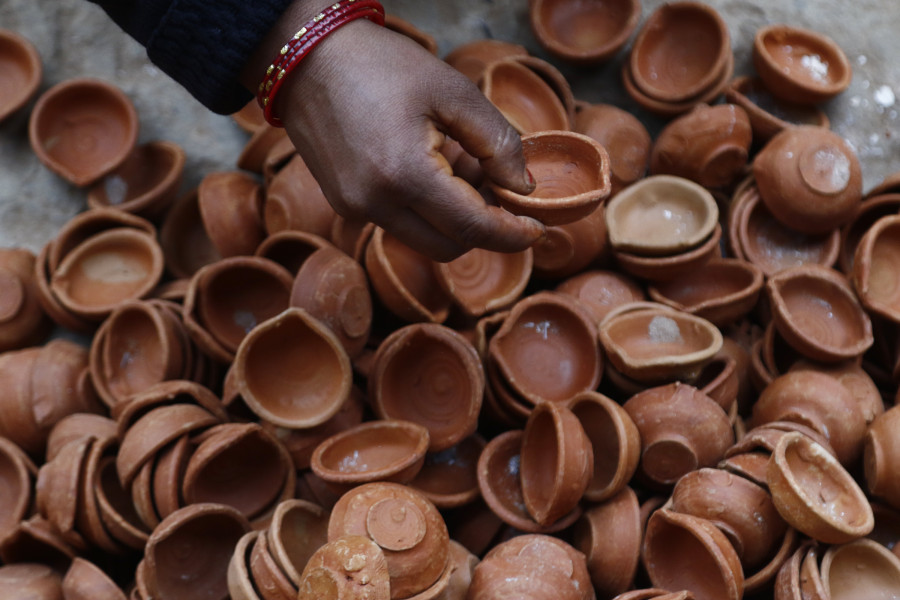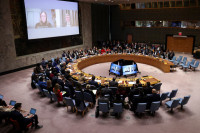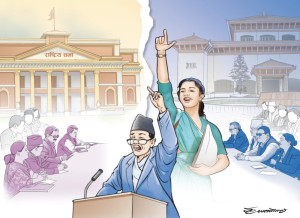Columns
Celebrating Deepawali sustainably
Let's promote degradable items and replace fancy lights with indigenous lamps.
Sramika Rijal
Among all festivals, Tihar is the most adorable one for many of us, including myself. Deepawali, which means "row of lamps" in Sanskrit, symbolises "victory of light over darkness". Goddess Laxmi is worshipped on the third day in the middle of the series of ceremonies to ensure good wealth throughout the year. It is believed that cleaning, lighting and decorating houses on this particular day is essential for a splendid entrance of Goddess Laxmi into the household. Indeed, Deepawali is called the festival of lights. But over the years, the way people celebrate this festival has changed. People's dependence on artificial ways of illuminating buildings has been increasing every year. I remember many cherished moments of lighting the house during childhood. I always find it mesmerising the way people made batti from cotton and used oil in diyo and paala for the lighting.
With the celebration of the festival, environmental issues like pollution, energy, waste and sustainability appear either directly or indirectly. We have a plethora of sustainable issues, and thus 17 sustainable development goals (SDGs) that need to be met by 2030. To resolve these issues, an appropriate way of celebrating festivals is equally essential. During Deepawali, while preparing one's home and other buildings for worshipping the goddess, we need to broaden our horizons and take the initiative to keep the environment safe and sound. From using non-biodegradable items for various purposes like lighting and making garlands to using plastic-made home decors and selecting the type of gifts and their wrappers, we are constantly overlooking the negative consequences on the environment.
In this scenario, have we ever felt the necessity of promoting and using degradable paala and diyo instead of a variety of bulbs that fall under hazardous wastes? Instead of importing electric decorative lights and other pieces worth hundreds of millions, why is there still a shortage of programmes and policies promoting degradable items? Even for recyclable items, waste management is still in a pathetic condition in the country, and importing those electric items is increasing the burden of hazardous waste whose management is even more arduous.
Harmful firecrackers
Another environmental issue is the use of firecrackers during this festival. Despite realising the air and noise pollution that occurs through their use, there is feeble monitoring and the regulation system in the country has not been successful in banning it altogether. Smoke from firecrackers add to severe air pollution, thereby cities, in particular, end up with more pollutants. Metals like cadmium, barium, lithium, magnesium and copper salts are used to manufacture firecrackers to produce the bright light when burnt. The toxic smoke contains benzene, carbon monoxide, nitrogen oxide, sulfur dioxide and ozone, primarily all major greenhouse gases (gases responsible for climate change).
Research in India has also shown that the ambient air quality is adversely affected due to emission and accumulation of particulate matter, sulfur dioxide, nitrogen dioxide and ozone by lighting firecrackers. Besides, a combination of these pollutants creates smog which is even more dangerous to health.
Another issue being ignored to date is agrobiodiversity for festivals. Deepawali is synonymous with flowers like marigold and makhamali. Enrichment of diversity in these horticultural species seems necessary. Always using a limited number of plants keeps us from thinking about the diversity of flowers that can be used on this auspicious occasion. It is already high time to think about the diversity of flowers and their use to meet the increasing demand for flowers every year. People still using artificial garlands have raised the scope for creating diversity concepts.
Besides, in the past, barley grains were used to prepare garlands for Bhaitika which are hardly seen nowadays. So, when the country faces a shortage of flowers, the use of alternatives like barley has not come out as an effective way due to lack of concern among stakeholders. Encouraging the use of barley itself is like a win-win situation in terms of agrobiodiversity conservation and less waste burden in the country during festivals.
Advance illumination
Another scenario happening these days is illuminating buildings long before the festival, even a week or month before in the name of Deepawali. At the same time, by lighting electric lamps continuously for several days, electricity consumption increases, limiting the amount of surplus electricity that could otherwise be used for various purposes. Surplus electricity can be sold or used in another way directly or indirectly that might help uplift rural people's livelihood. How practical an approach it would be for sustainability. Similarly, suppose we start searching for alternatives like diyo and paala for electric lights, rural employment increases every coming year. In that case, every rural community is going to be self-reliant for festival celebrations. Isn't it another step towards sustainability?
So, this year, let every individual from all corners of the country join hands for a sustainable way of celebrating the festival by promoting degradable and reusable items for packing gifts and embellishing houses, and replacing the fancy candles and lights with indigenous diyo and paala. In addition, making rangoli during Deepawali is common nowadays in every household. Rather than making it with harmful colours, let's go back to an underived way by using rice, pulses and turmeric with some flowers and leaves. This practice will create a safer rangoli as compared to contemporary ones. Let's embrace the true essence of Deepawali in the best possible way. Wishing you all a happy, safe and sustainable Deepawali celebration.




 16.2°C Kathmandu
16.2°C Kathmandu















